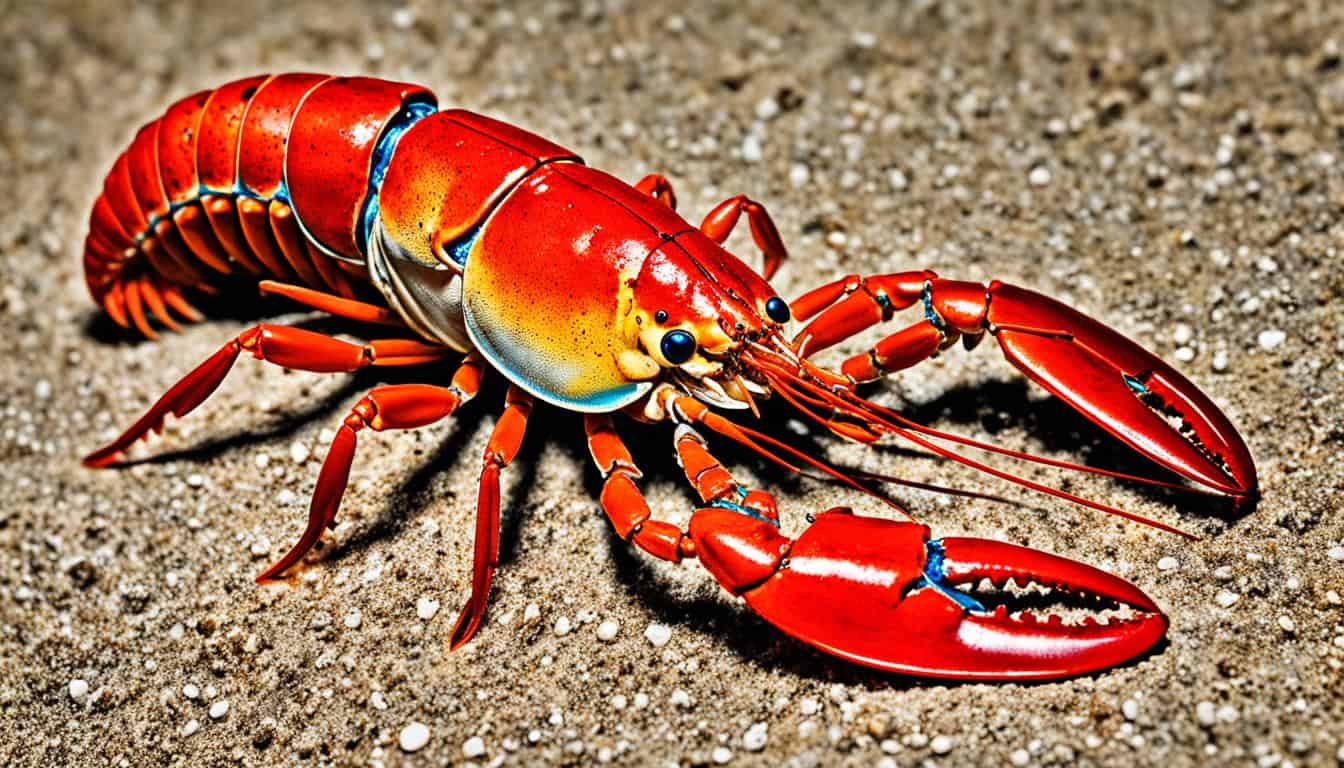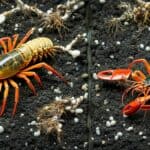Ever wondered, “What are lobsters?” You’re not alone. These marine creatures belong to the Nephropidae family. They are known for their long bodies, strong tails, and big claws. Lobsters live in various ocean areas and are a big deal in the seafood world.
The American lobster (Homarus americanus) is a well-known type found along North America’s eastern coast. Their popularity has made lobster facts interesting to many. This has made them a key part of the fishing industry.
In U.S. waters, you’ll mostly find two types of lobsters. The “true” lobsters, like the American lobster, and the clawless spiny lobsters. These creatures are important for the environment and culture. They interest both scientists and seafood fans with their life cycle and behaviors.
Overview of Lobsters
Lobsters are fascinating marine animals with a big impact on the economy and unique traits. They belong to two main families: Homaridae and Palinuridae. The American lobster is a key example, living from Newfoundland to North Carolina. Spiny lobsters, without big claws, live in warm waters.
Lobsters have tough shells that protect them on the ocean floor. They move through different types of sea floor with ease. At night, they hunt for food, eating both living and dead things. This shows how important they are to the ocean’s balance.
What are lobsters?
Lobsters are amazing sea creatures that belong to the class Malacostraca and the order Decapoda. They are divided into two main families: Nephropidae and Palinuridae. These families include the true lobsters like the American lobster and the spiny lobsters.
Definition and Classification
Lobster classification is complex, with many genera and species. True lobsters have big claws on their first three legs. Spiny lobsters don’t have these claws and look different. These differences help us understand their unique ways of living in the ocean.
Lobster Species
In U.S. waters, there are many lobster species. The American lobster (Homarus americanus) is one of the most well-known. It has a green or brown color that helps it hide in rocky places.
Spiny lobsters (Palinurus spp.) are brightly colored. They use their colors to talk to each other and hide from predators. Other important lobsters include the European lobster (Homarus gammarus) and the Norway lobster (Nephrops norvegicus), also called scampi.
Each lobster species likes different places to live and can be found in different areas. The American lobster is very important in the seafood market, especially in New England.
Lobster Anatomy
Lobster anatomy is truly fascinating, showing how they survive in deep ocean waters. By looking at their body structure, we learn about their survival skills. Each part of their body has a special job that helps them live.
Body Structure and Function
A lobster’s body is split into two main parts: the cephalothorax and the abdomen. The cephalothorax has important senses like compound eyes and long antennae for finding food and navigating. Its strong exoskeleton protects the lobster’s insides and keeps it shaped right, even under pressure.
Lobsters have powerful claws and many walking legs that help them move over different sea floors. Their abdomen has swimmerets for swimming and a strong tail for fast swimming when they need to get away from danger.
Color and Skin Composition
The color of lobsters comes from their skin, which helps them hide in the ocean. They usually look bluish-green to brownish, matching the sea floor. When cooked, they turn bright red because of changes in their proteins that release a pigment.
Their skin also protects their organs well. Their blood is different, using hemocyanin instead of hemoglobin, which gives it a blue color when full of oxygen.

Types of Lobsters
Learning about the different types of lobsters is key to understanding their role in nature and their value in cooking. In U.S. waters, there are two main types: true lobsters and spiny lobsters.
True lobsters, like the American lobster, are known for their big claws. These are often caught for food and are a common sight in seafood places. They have some special features:
- Distinctive claws that help them defend themselves and catch food.
- Preference for colder waters, usually found along the Atlantic coast.
- Rich flavor profile, making them popular in fancy dishes.
Spiny lobsters don’t have big claws like true lobsters. They are known for their strong tail. They live in warm waters and can be found in many places. Here are some things about spiny lobsters:
- Primary consumption of their tails, which are a treat for many.
- Adaptation to warm waters, found in places like the Caribbean and the southeastern U.S.
- Robust exoskeleton that protects them from predators.
Other types of lobsters, like the European lobster and the Norway lobster, show how diverse lobsters can be. Each type has special traits that help them live in different places. Below is a table that lists some lobster types, where they live, and their importance in cooking:
| Type of Lobster | Habitat | Culinary Value |
|---|---|---|
| True Lobster (American) | Cold Atlantic waters | Highly sought after for its sweet meat |
| Spiny Lobster | Warm coastal waters | Famous for its tender tail meat |
| European Lobster | North Atlantic | Considered a delicacy in many cuisines |
| Norway Lobster | North-East Atlantic | Known for its flavorful meat, often used in seafood dishes |
Lobster Behavior
Understanding lobster behavior is key to knowing their role in the ocean. These creatures have unique ways of eating and mating that help them survive and reproduce. By learning about these behaviors, we can better appreciate their life cycle and the challenges they face.
Feeding Habits
Lobsters are mostly active at night, using their strong sense of smell to find food. They are known to eat both dead and live organisms, including fish and other crustaceans. This shows their important role as both scavengers and predators in different environments.
In some cases, when food is scarce, lobsters may even eat each other. This behavior highlights the need to understand their feeding habits in their natural settings.
Mating and Reproduction
Lobsters mate in the summer, during their molting season, when females are most ready. After mating, females can store sperm for a long time. This leads to a wide range of eggs, from 3,000 to 75,000, which attach to the female’s swimmerets.
These eggs hatch into tiny larvae that float in the water before settling on the ocean floor. This complex reproductive process is crucial for the survival of lobster populations and helps them adapt to environmental changes.
FAQ
What are lobsters?
Lobsters are marine crustaceans in the family Nephropidae. They have long bodies, strong tails, and big claws. They play a big role in the ocean’s balance and are loved for their taste.
What types of lobsters exist?
There are mainly two kinds of lobsters. True lobsters, like the American lobster, have claws. Spiny lobsters, without claws, live in warmer waters.
What is the anatomy of a lobster like?
Lobsters have a body divided into two parts: the cephalothorax and abdomen. They have strong claws, walking legs, and swimmerets for moving around.
How do lobsters behave in their environment?
Lobsters are mostly active at night. They use their senses to find food, which can be alive or dead. They also have unique ways of mating in the summer.
What do lobsters eat in the wild?
Lobsters eat a variety of things, including live and dead animals. Their diet includes fish, mollusks, and other crustaceans. They adjust their eating habits based on what’s available.
Where do lobsters typically live?
Lobsters live in different ocean floors, like rocky, sandy, or muddy areas. Where they live depends on the species. True lobsters prefer cold waters, while spiny lobsters like warmer climates.
Why are lobsters considered economically significant?
Lobsters are important for the economy because they are popular seafood. The American lobster is especially sought after in the U.S. and around the world.
How do lobsters reproduce?
Lobsters mate in the summer. Females can store sperm for later use. They can lay thousands of eggs, which hatch into tiny larvae after a while.







